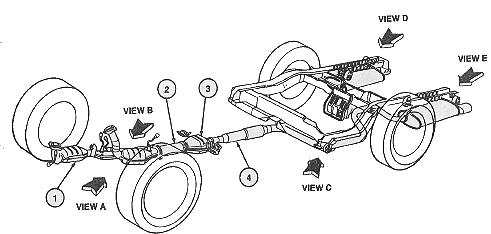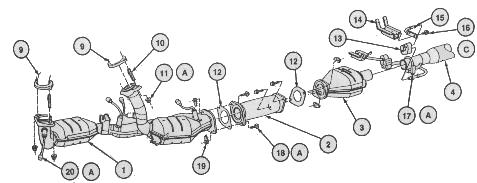

Description
The SHO exhaust Stainless Steel exhaust system has two Three Way Catalytic
Converters (TWC), (1, below). The front bank of cylinders runs to the passenger
side and the rear to the drivers side. The passenger side converter is
located directly beside the oil pan which would be a good motivation to
use a temperature tolerant synthetic motor oil. Each TWC has a heated oxygen
sensor both fore and aft (total of four) that must be disconnected before
working on the exhaust system.

After the pair of TWC is a Y pipe and a 2.5" flange which bolts to
a flex pipe (2, above) and a "muffler" that sure looks like yet another
catalytic converter (3, above) no matter what the helms calls it. It has
been noted that the 3rd converter is required to insure the SHO will still
pass emissions tests until 100,000 miles but may not be required or necessary
to pass emissions tests. It has a reputation for causing a lot of back
pressure.

After the 3rd cat is a long tubular glass packed shaped muffler (4,
in both diagrams above), then the exhaust splits at a Y and runs back "over
the axle" to the two final mufflers.
Modifications
The even firing V8 has a pleasant note that can be difficult to detect, it is a pleasant voice of little volume. Starting with the least expensive modification the factory mufflers are 21" long and 2 ¼" inlet and outlet but at the hangers on either side of the pipes crimp down to 1 5/8" At the loss of 2 quality SS mufflers that would last forever about 5 HP can be found by replacing the factory mufflers with something more sporting like a shorter 14" turbo.
Be sure to put the factory tips back on the new mufflers or the cutout in the rear bumper will look empty.
The third cat costs about 7 HP and the SHO Shop makes a by-pass pipe for "off road use" only. It may cause you to fail a visual emissions test in your area. The SHO Shop also sells a Cat back SS system said to add 12 HP. By pass pipe and cat back system together provide a 19 HP improvement. Borla also makes a SS cat back system, measured improvement unknown. Either system will provide the SHO with a voice much more noticeable that the factory system.
update - On a chassis Dynojet it is very difficult to get accurate low-mid rpm torque (idle-4000 rpm) readings. Some evidence exists that exhaust modifications to improve peak HP may HURT low end torque and ET's.